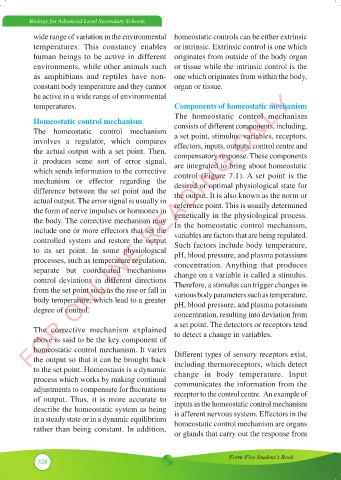Page 335 - Biology_F5
P. 335
Biology for Advanced Level Secondary Schools
wide range of variation in the environmental homeostatic controls can be either extrinsic
temperatures. This constancy enables or intrinsic. Extrinsic control is one which
human beings to be active in different originates from outside of the body organ
environments, while other animals such or tissue while the intrinsic control is the
as amphibians and reptiles have non- one which originates from within the body,
constant body temperature and they cannot organ or tissue.
FOR ONLINE READING ONLY
be active in a wide range of environmental
temperatures. Components of homeostatic mechanism
The homeostatic control mechanism
Homeostatic control mechanism consists of different components, including,
The homeostatic control mechanism a set point, stimulus, variables, receptors,
involves a regulator, which compares effectors, inputs, outputs, control centre and
the actual output with a set point. Then, compensatory response. These components
it produces some sort of error signal, are integrated to bring about homeostatic
which sends information to the corrective control (Figure 7.1). A set point is the
mechanism or effector regarding the desired or optimal physiological state for
difference between the set point and the the output. It is also known as the norm or
actual output. The error signal is usually in reference point. This is usually determined
the form of nerve impulses or hormones in genetically in the physiological process.
the body. The corrective mechanism may In the homeostatic control mechanism,
include one or more effectors that set the variables are factors that are being regulated.
controlled system and restore the output Such factors include body temperature,
to its set point. In some physiological pH, blood pressure, and plasma potassium
processes, such as temperature regulation, concentration. Anything that produces
separate but coordinated mechanisms change on a variable is called a stimulus.
control deviations in different directions Therefore, a stimulus can trigger changes in
from the set point such as the rise or fall in various body parameters such as temperature,
body temperature, which lead to a greater pH, blood pressure, and plasma potassium
degree of control.
concentration, resulting into deviation from
a set point. The detectors or receptors tend
The corrective mechanism explained to detect a change in variables.
above is said to be the key component of
homeostatic control mechanism. It varies Different types of sensory receptors exist,
the output so that it can be brought back including thermoreceptors, which detect
to the set point. Homeostasis is a dynamic change in body temperature. Input
process which works by making continual communicates the information from the
adjustments to compensate for fluctuations receptor to the control centre. An example of
of output. Thus, it is more accurate to inputs in the homeostatic control mechanism
describe the homeostatic system as being is afferent nervous system. Effectors in the
in a steady state or in a dynamic equilibrium homeostatic control mechanism are organs
rather than being constant. In addition,
or glands that carry out the response from
Form Five Student’s Book
328

